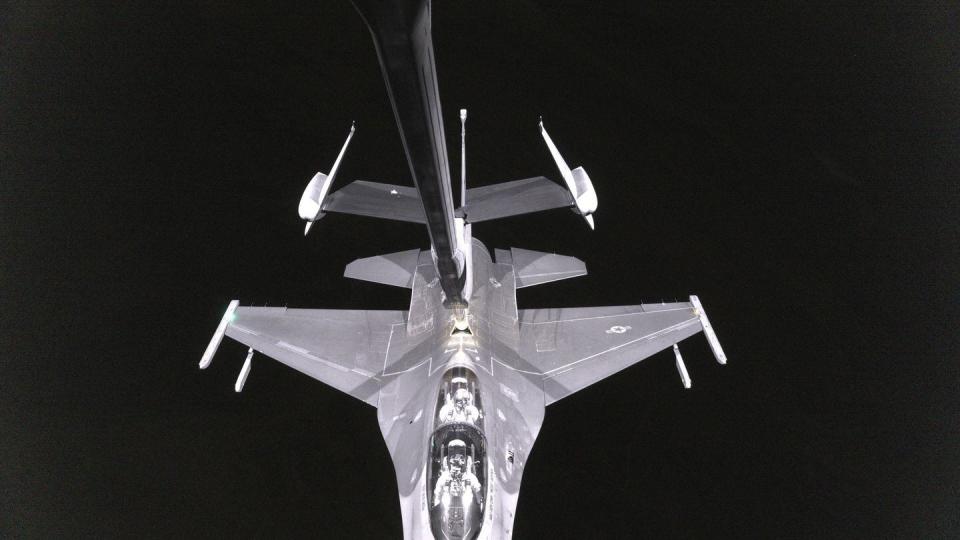‘Cautionary tale’: How Boeing won a US Air Force program and lost $7B
WASHINGTON — The U.S. Air Force’s next-generation tanker was supposed to be the ideal candidate for a fixed-price development program.
Indeed, when Boeing first won the deal to build what’s now known as the KC-46, the defense contractor said it would use a “low-risk approach,” basing its design on the existing Boeing 767 commercial airplane. The contract was firm-fixed-price, meaning Boeing was on the hook if costs ran higher than expected.
Nearly 13 years later, Boeing has absorbed $7 billion in cost overruns, far more than the contract value of $4.9 billion. For years, the tanker, designed to refuel aircraft in flight, has been plagued by delays, production errors and a faulty vision system that required a complete redesign.
While Boeing has paid the financial price, the company and the Air Force have spent years trying to make the program work. The initial contract award called for the combat-ready tankers to arrive in August 2017; the first arrived in January 2019.
In the years that followed, the KC-46 program was beset by further delays, including production line problems that regularly stalled deliveries and an underperforming vision system. That system is years behind schedule and expected to come in October 2025.
Boeing’s experience with the KC-46 and other programs in recent years has turned into a “cautionary tale” on the risks of entering into fixed-price development contracts, said Steven Grundman, a former Pentagon industrial base chief who now works as a senior fellow at the Atlantic Council think tank.
The KC-46 story “makes both sides of the market — the Pentagon and the contractors — sharpen their pencils,” Grundman said. “The Pentagon will be more cautious about programs that it thinks [lend themselves to] an efficient and effective fixed-price contract type. And contractors will be more discerning about the readiness of their engineering chops and the ability of their balance sheets to absorb risk.”
While analysts don’t expect the Pentagon to entirely shy away from fixed-price contracts, they said the military and businesses will think long and hard about which future deals make sense for such a contract structure — and when another path might better serve a program.
Air Force Secretary Frank Kendall, who was the Pentagon’s deputy acquisition chief when the original tanker contract was awarded, has said the service didn’t look closely enough at some design elements and wasn’t skeptical enough of the rosy picture Boeing painted.
And he has acknowledged a cost-plus contract, meaning one that covers a company’s expenses as well as some profit, might have been a better choice — for both sides.
“In a fixed-price, you’ve got to let the contractor kind of do what it wants because he’s taking the risk associated with the cost,” Kendall said.
L3Harris Technologies’ chief executive told investors in an April earnings call that concerns over the risk of fixed-price contracts prompted the company to pass on two opportunities it otherwise found “exciting.”
“It’s very hard to commit to a fixed-price development program when you don’t know the spec,” Chris Kubasik said. “We all look back at all the write-offs and losses, and more times than not they’re tied to that. So we will not be playing that game.”
‘No quarter’ for fixed-price mistakes
Under firm-fixed-price contracts of the kind Boeing received to build the KC-46, the contractor agrees to deliver a product or service for a hard-and-fast price, and shoulders the cost of any overruns or changes that weren’t originally agreed upon with the government.
But while the contractor bears the brunt of the risk under a fixed-price deal, it can also pay off considerably if the company plays its cards right. While other forms of contracts limit profit margins to between 5% and 12%, under a fixed-price contract, companies can keep any leftover money. If they come in under cost, they reap all the benefits.
Bryan Clark, the director of the Center for Defense Concepts and Technology at the Hudson Institute think tank, said there will always be a place in the Pentagon for fixed-price contracts.
“The idea of fixed-price contracts is still very popular within the [Department of Defense] because contracting officers like it; it’s a good way to show that you’re holding the line” against cost overruns, Clark said.

Some contracting experts said fixed-price deals can make sense for straightforward projects, but more complicated development programs are not necessarily an ideal fit.
Defense industry analyst Loren Thompson said if a company can’t turn a profit on a program — or worse, starts bleeding cash as it spirals — the company might start looking for places to cut corners to save. That, he explained, can lead to moves detrimental to the program over the long run — and perhaps years of delays and headaches for the client, even if they’re not financially on the hook.
“If you’re not breaking even on a program, then you start thinking: What don’t I have to do that was in my original plan?” Thompson said. “And it can lead to trouble.”
(Thompson previously consulted for Lockheed Martin, though he no longer does so. Lockheed and Boeing contribute to the Lexington Institute think tank, where Thompson is chief operating officer.)
Boeing’s KC-46 experience shows companies can’t expect the Pentagon to bail them out if things start to go sideways on a fixed-price contract, Grundman told Defense News. During the Cold War, he said, the Pentagon was more willing to help when such a contract started to balloon out of control and endanger a company. But those days are gone, he noted, ever since the wave of industry consolidations led to mega-firms with multibillion-dollar revenues.
“The Pentagon is going to give no quarter to companies that make mistakes in how they bid on these things,” Grundman said. “These [primes] are big boy companies, [with] big balance sheets that the Pentagon can ask to bear more risk.”
In recent years, Boeing has made more than one big bet on a fixed-price program. In 2018, the company won deals for the T-7A Red Hawk trainer, MQ-25A Stingray tanker drone and VC-25B Air Force One programs, all fixed-price efforts that have contributed to billions of dollars in charges for Boeing.
“Boeing wanted to win the work, so they went for these fixed-price [research and development] contracts and lowballed it, and now they’re suffering,” Clark said.
Lockheed Martin lost three major contracts to Boeing in 2018, including the T-7 and MQ-25. Lockheed’s chief executive at the time, Marillyn Hewson, told investors that if the company had matched Boeing’s price, then Lockheed would have lost more than $5 billion.
The Trump administration’s hardball renegotiating of the VC-25B contract with Boeing — which CEO Dave Calhoun has publicly lamented — also ratcheted up the company’s risk.
“There was a lot of risk in that [Air Force One project] because it’s not easy to convert a plane that already exists to perform a different function,” Clark said. “The government squeezed them pretty hard to give them a fixed price, and [Boeing] had to lowball it, and now they’re having to take those losses.”
Boeing, still smarting from the contracting licks it took — and, for now, will continue taking — is going to great lengths to show its investors it learned lessons.
“Rest assured, we haven’t signed any fixed-price development contracts, nor [do we] intend to,” Boeing’s chief financial officer, Brian West, said in the company’s October earnings call.
And on Dec. 4, a Boeing spokesperson confirmed the company is no longer competing to provide the Air Force with a successor to the E-4B Nightwatch, a so-called doomsday plane meant to serve as a survivable command, control and communications center during nuclear war.
“We are approaching all new contract opportunities with added discipline to ensure we can meet our commitments and support the long-term health of our business,” the spokesperson told Defense News.

Reuters reported the service’s insistence on using a fixed-price structure for the contract, which Boeing has sworn off, was an insurmountable disagreement.
Boeing declined to confirm whether a fixed-price dispute was a factor, and the Air Force declined to comment on the ongoing competition.
Clark said Boeing’s experience has prompted firms to be more wary of fixed-price contracts and more reluctant to accept those kinds of deals during the higher-risk research and development phase.
“There’s definitely been a new openness on the part of DoD contracting officers to accept cost-plus [contracts] on the R&D side,” he said. Companies now say they “want R&D to be a cost-plus endeavor, where we’re getting covered in terms of our overruns. Because the government always asks for something pretty ambitious, therefore, it makes sense that the government helps to pay for or cover the risk associated with those ambitious goals.”
No ‘vanilla Wedgetail’
For its B-21 Raider bomber, the Air Force has applied both a cost-plus and fixed-price approach. The service used a cost-plus approach for the 2015 contract it awarded Northrop to develop the Raider, and the soon-expected low-rate initial production contract will use a fixed-price structure.
That cost-plus structure raised eyebrows at the time, particularly from the late Sen. John McCain, R-Ariz., who worried it would lead to cost overruns and schedule slips. But after the Raider’s on-time and on-budget rollout in December 2022, former Air Force Secretary Deborah Lee James said it was clear the cost-plus structure and the way the Air Force had managed Northrop Grumman’s incentives worked.
Clark also praised the Air Force’s contracting approach.
“That’s obviously partly a function of Northrop Grumman’s superior execution, but it’s also a function of the contracting in a way that’s sustainable for the company,” he said.
But Thompson, the defense analyst, said rockier roads could lie ahead for Northrop in the production phase. Several times last year, the contractor’s chief executive, Kathy Warden, cautioned investors it’s unlikely the B-21 will initially turn a profit, and that Northrop could lose up to $1.2 billion on the low-rate initial production contract.
In January 2023, Warden attributed the rising cost estimates for the low-rate initial production contract to “unprecedented” inflation, supply chain disruptions and labor issues. However, she expressed confidence the B-21 would keep driving future growth for Northrop.
But Thompson said inflation isn’t the entire story here, as Northrop had bid aggressively to win the coveted and highly advanced bomber contract.
Northrop “actually underbid an aggressive proposal from Boeing and Lockheed,” Thompson said. Now “they’re concerned about how little money they may make on production. The way they presented this publicly is, ‘Oh, we forgot to put an inflation clause in the contract.’ And maybe that’s close to it, but when you have a very challenging concept for a future program and you bid fixed price, it’s a crapshoot.”
The Air Force’s $1.2 billion deal in March for Boeing to start rapid prototyping of the E-7A battle management aircraft took a different approach. That deal uses the cost-plus structure, the Air Force said.

In a statement to Defense News, the Air Force said it chose that approach to balance the risk between the service and Boeing, and because of modifications the American version of the E-7 will require.
The Air Force’s E-7 will be based on the configuration Boeing is already making for the United Kingdom, the service said, but its design will be tweaked to meet the United States’ standards for satellite communication, military GPS, and cybersecurity and program protection requirements.
The Air Force’s use of a cost-plus contract for E-7s, which will replace its aging and retiring E-3 Sentry fleet, makes sense because of the modifications, Clark and Thompson said. Australia also flies the E-7, which it dubbed Wedgetail, but its version too differs in several ways from the American one.
“This is not going to be a vanilla Wedgetail,” Thompson said. “Wedgetail has been flying a long time, and it’s a sole source for Boeing. From the Air Force’s point of view, those two facts make … going fixed price sound more reasonable. But I think that underestimates how much uncertainty there is in the integration and future evolution of the airframe.”
If the Air Force conducts rigorous oversight on the E-7′s prototyping, Thompson said, the cost-plus structure could give Boeing the flexibility it needs to meet the cost requirements while netting a decent return. And in return, he said, the Air Force could get a better product out of Boeing.
“Wedgetail presents an opportunity to rigorously balance the concerns of the customer with those of the contractor,” Thompson said. “As long as that [government oversight] happens, giving the contractors a little more flexibility can pay big dividends.”
Boeing had a stronger hand with which to negotiate, Clark said, since there wasn’t another ideal candidate to replace the older airborne warning and control system aircraft. Boeing was “in a good position and felt like they didn’t need to underbid everyone else,” he added.
But Thompson said the Air Force’s move to a cost-plus structure for the E-7 may be a sign of lessons learned about the risks that can come with fixed-price contracts.
“Kendall understands acquisition better than anybody else in the [Pentagon’s] E ring,” Thompson said, referring to the building’s outer ring of hallways where many of the military’s most senior leaders have their offices. “And I think he has relearned an old lesson: You get what you pay for. You can either pay for it up front or you can pay for it down the road, but at the end, you get what you pay for.”

